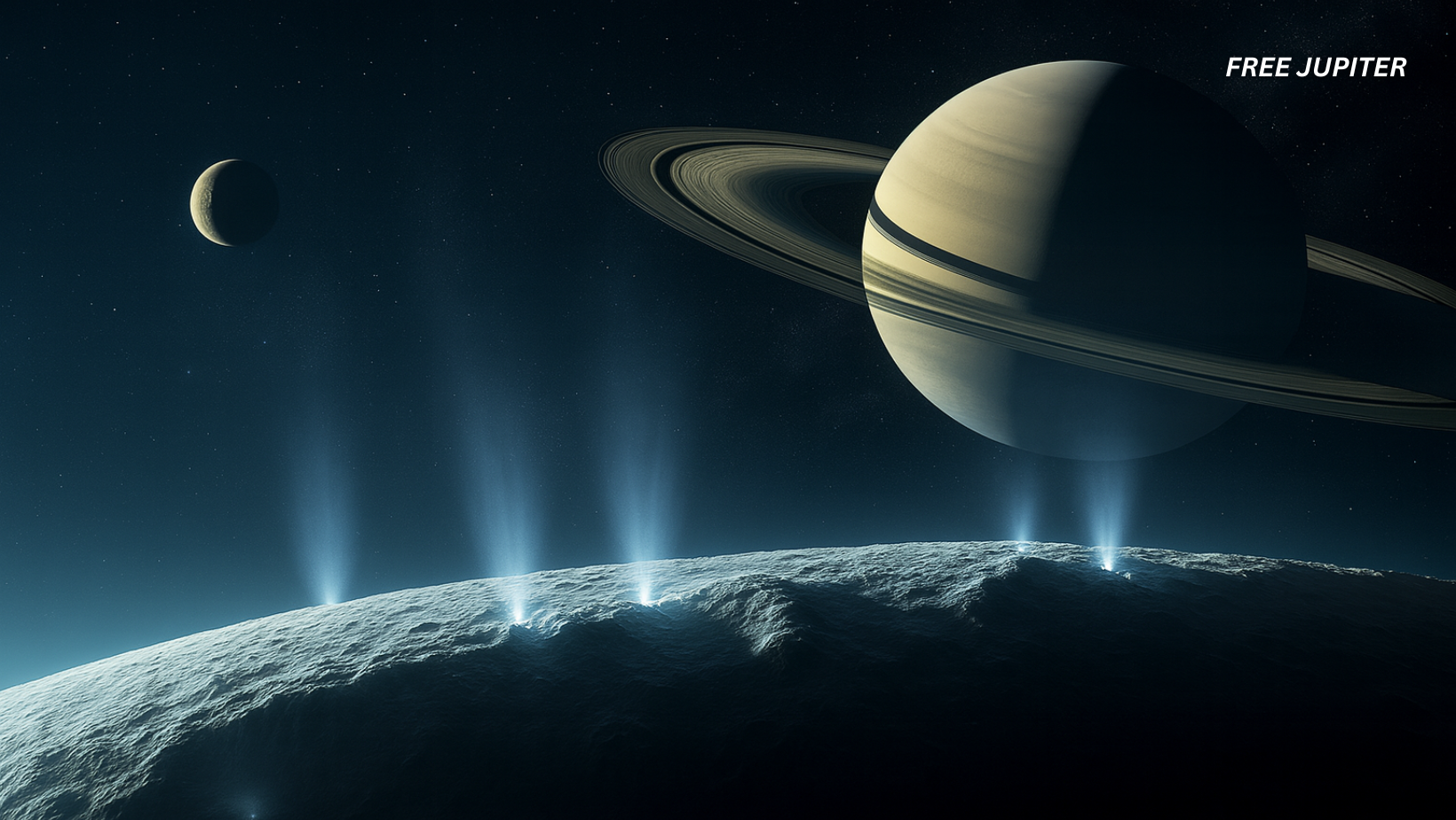Among Saturn’s more than 140 moons, Enceladus stands out as one of the most fascinating. Though only about 500 kilometers (roughly 310 miles) across, this tiny, glimmering world has captured the imagination of scientists and space enthusiasts alike. Covered in bright ice that reflects sunlight like a cosmic mirror, Enceladus looks peaceful from afar—but beneath that calm exterior lies a realm of mystery and potential activity.
For years, researchers have been piecing together clues suggesting that Enceladus might not be a dead, frozen world after all. Instead, it appears to hide a vast, global ocean beneath its icy crust—an ocean that may contain the essential ingredients for life. The newest findings, published in Nature Astronomy, add even more depth to this growing intrigue.
Discovering Hidden Chemistry in the Icy Plumes
The latest research has detected previously unknown organic compounds—carbon-based molecules that serve as the backbone of all living things. These were found in the icy material ejected from Enceladus’s surface, which forms massive plumes that shoot into space through fractures near the moon’s south pole.
These plumes were first discovered in 2005 by NASA’s Cassini spacecraft, which spent over a decade studying Saturn and its moons. During several close flybys, Cassini actually flew through these icy jets, collecting data and microscopic particles that have kept scientists busy ever since.
In this most recent analysis, researchers used advanced techniques to reexamine the data, identifying organic molecules that had gone unnoticed in earlier studies. These include complex carbon compounds similar to those found in comets, meteorites, and even early Earth’s ancient oceans. Such molecules are vital for forming amino acids, proteins, and other biological materials.
Read more: If They Say These 8 Phrases to a Server, They Have No Empathy
The Possibility of a Hidden Ocean World
Beneath Enceladus’s icy crust lies an enormous saltwater ocean, believed to be in contact with a rocky core. That connection is crucial—it could enable chemical reactions similar to those that support life near Earth’s hydrothermal vents.
Here on Earth, deep-sea vents spew mineral-rich water into the ocean, creating ecosystems that thrive without sunlight. Tiny microorganisms feed on the chemical energy released from these reactions, forming the base of an entire food chain. Scientists suspect that something similar could be happening under Enceladus’s frozen surface.
If hydrothermal vents exist there, they could be releasing heat, minerals, and organic molecules into the subsurface ocean—creating the perfect laboratory for prebiotic chemistry or even microbial life.
Organic Compounds: The Building Blocks of Life
The newly identified compounds are more than just interesting chemical discoveries—they’re pieces of a much larger puzzle. Organic molecules contain carbon, hydrogen, nitrogen, oxygen, and other elements essential for forming complex biological systems.
The presence of these molecules suggests that Enceladus’s ocean is chemically active and potentially hospitable. Scientists have previously found methane, carbon dioxide, and hydrogen in the moon’s plumes—gases often linked to biological processes on Earth. Combined with these new discoveries, the evidence continues to grow that Enceladus has all the ingredients necessary for life to exist—or at least to emerge.
While no one has yet detected living organisms, the chemistry points to an environment that could support them. In other words, Enceladus may be ticking all the right boxes for habitability.
What Makes Enceladus So Unique?
Enceladus isn’t the only icy moon in the solar system that may hide an ocean. Jupiter’s moon Europa and Neptune’s moon Triton are also thought to have vast subsurface seas. But what makes Enceladus especially captivating is how accessible its secrets are.
Because its ocean vents shoot material directly into space, scientists can study the moon’s chemistry without having to drill through kilometers of solid ice. Cassini’s flybys proved that analyzing these plumes is like taking a natural sample of the ocean below, a rare scientific advantage in planetary exploration.
This means future missions could potentially detect biological signatures without even landing on the moon. It’s as if Enceladus is offering us a glimpse of its hidden world, one icy particle at a time.
How Scientists Study an Alien Ocean from Millions of Miles Away
Studying Enceladus from Earth isn’t easy—it orbits Saturn nearly a billion miles from the Sun. But spacecraft like Cassini have revolutionized our understanding of such distant worlds. The data gathered from the mission continues to fuel new discoveries years after Cassini’s dramatic dive into Saturn’s atmosphere in 2017.
Researchers use mass spectrometers to analyze the chemical makeup of the icy grains collected from the plumes. By comparing their composition with known Earth-based materials, scientists can identify molecules that suggest biological or prebiotic activity.
Even with all these tools, however, much remains uncertain. The findings raise as many questions as they answer: How stable are these organic compounds? Are they products of geological reactions—or could they be remnants of something once alive?
Read more: 14 Reasons Why It’s Perfectly OK Not to Like Someone
A Beacon for Future Exploration
The discoveries on Enceladus have made it one of the top priorities for future missions. NASA and the European Space Agency have both discussed potential projects that could return to Saturn’s orbit with more advanced instruments capable of sampling the plumes more thoroughly.
One proposed mission, called Enceladus Orbilander, would orbit the moon before landing near its south pole to study the jets up close. It would analyze the chemistry, search for biosignatures, and potentially answer one of humanity’s most profound questions: Are we alone in the universe?
If life—or even traces of biological activity—are found on Enceladus, it would reshape how we understand life’s potential beyond Earth. It would prove that life can emerge in environments very different from our own, surviving without sunlight and under kilometers of ice.
The Broader Cosmic Implication
Beyond the search for life, discoveries on Enceladus are changing how scientists think about habitability in general. They challenge the long-held belief that only planets close to their stars can host life. Instead, Enceladus shows that even small, distant worlds can have enough warmth and chemistry to sustain living conditions, thanks to tidal heating—the gravitational pull from Saturn that keeps the moon’s interior warm.
This opens the door to countless possibilities across the universe. If tiny moons orbiting gas giants can harbor oceans and organic chemistry, then habitable environments might be far more common than we ever imagined.
Read more: 12 Phrases Mindless People Repeat Over and Over, According To Psychology
A Frozen World with a Warm Secret
Enceladus may appear cold, quiet, and unassuming, but it continues to whisper hints of something extraordinary beneath its icy shell. Each new discovery brings us closer to understanding not only what lies beneath its shimmering surface, but also what it means for life elsewhere in the cosmos.
As one of the most promising candidates for harboring extraterrestrial life, Enceladus reminds us that even in the farthest, coldest corners of our solar system, the potential for life finds a way to persist.
Featured image: GPT-5o
Friendly Note: FreeJupiter.com shares general information for curious minds. Please fact-check all claims and double-check health info with a qualified professional. 🌱










